
Like a Dragon: Pirate Yakuza in Hawaii Review
Ever since his debut in the first Yakuza entry on the PlayStation 2, Goro Majima has continually captivated many Like a Dragon series fans throughout the years. The chaotic madness he brought spiced up Kazuma Kiryu’s adventures, since his allegiances constantly seemed in flux. Majima’s popularity exploded when Yakuza 0 delved into his origin story, and he shared the spotlight with Kiryu as its second playable protagonist.
Besides Yakuza 0, there were only a few other times that Majima was playable – the newly added “Majima Saga” side story in Yakuza Kiwami 2 and the zombie shooter spin-off Yakuza: Dead Souls. He wasn’t the protagonist in either of these installments though; it wasn’t until Like a Dragon: Pirate Yakuza in Hawaii that Goro Majima finally got his full-fledged game as the sole playable main character.
While Pirate Yakuza in Hawaii doesn’t carry the ‘Gaiden’ moniker in its western name, the Japanese title does consider it the next entry in the ‘Gaiden’ canon sub-series that previously began with The Man Who Erased His Name. The events of Pirate Yakuza in Hawaii take place several months after Infinite Wealth; it isn’t absolutely mandatory to have played Infinite Wealth to understand most of the main storyline, but I still highly recommend it. Pirate Yakuza in Hawaii fills in a good chunk of unanswered questions about secondary plot elements in that entry, especially the Palekana group that it introduced.
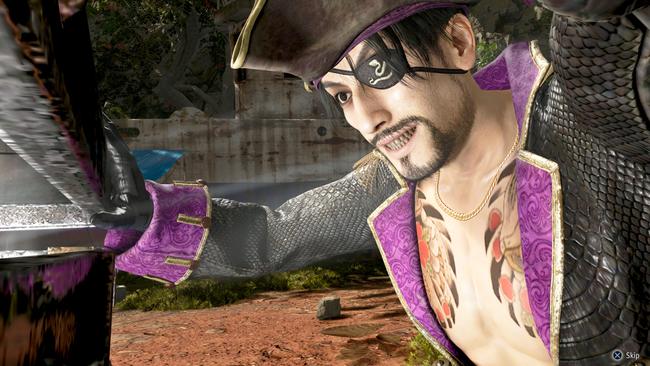
The first hour of this game sucks. It has Majima wash ashore on an island without his memories, and a young boy named Noah discovers him. Majima is brought to Noah’s settlement soon after, where he meets Noah’s dad Jason and older sister Moana; the amnesia-ridden legend knows he’ll find no answers on the island and begins to explore ways off it.
This begins an introduction to Pirate Yakuza in Hawaii’s weak quasi-survival elements, as the narrative slowly unfurls Majima’s dwindling options and Noah’s desire to explore the world beyond the only place he’s ever known. Despite its small runtime on paper, this intro section feels drawn out and highlights several of the weakest sub-systems that Pirate Yakuza in Hawaii has to offer, except the amusing cooking minigame. Although this installment doesn’t provide a great first impression from the get-go, it quickly begins to show its chops when Majima finds himself the unexpected golden ticket off the island – becoming the captain of a pirate ship.
I feel incredibly mixed about how Pirate Yakuza in Hawaii paces out its main narrative and what elements it chooses to prioritize. The second chapter kicks off right as players acquire the pirate ship and gradually opens up a vast amount of the game’s locations and gameplay pillars; this includes substories, minigames, some major characters, the numerous newly added naval elements, and much more. Before I dive deeper into the gameplay elements of Pirate Yakuza in Hawaii, I’ll try my best to illustrate my qualms with its story beats as spoiler-free as possible.
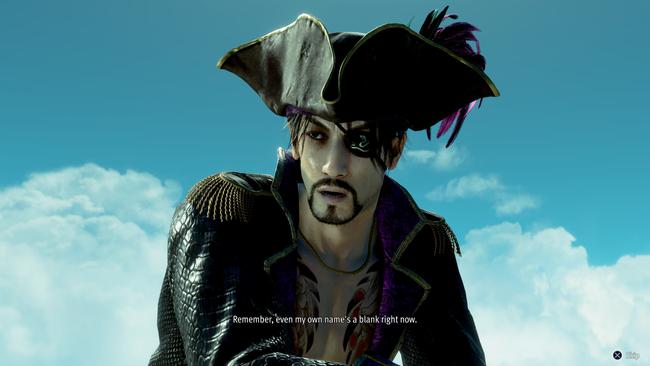
Part of what makes Majima such a compelling figure throughout RGG Studio’s flagship franchise is how he disguises his cunningness with an eccentric aesthetic; there is usually an underlying big picture he’s striving towards, but he isn’t always the most overt about it. An amnesiac Majima doesn’t necessarily diminish what makes him a fun character, but there is a certain essence missing that permeates throughout the whole game.
Majima’s primary reason for briefly taking up the life of a pirate is his way of thanking Noah for saving his life. It also serves as a convenient method to operate independently from other factors, yet this newfound pirate life is mostly to fulfill Noah’s dreams. This dynamic inversely places Majima’s personal story on a secondary note because any narrative element that involves him prior to the events of Pirate Yakuza in Hawaii is washed away with Majima’s constant reminders that he has no memories and frankly, isn’t in any rush to retrieve them due to how much he’s enjoying the pirate life.
Therefore, even though Pirate Yakuza in Hawaii finally stars Majima as the sole main character, it’s hard to shake the feeling that he is still playing second fiddle to someone else’s story. For the vast majority of the game, his interactions with familiar faces boil down to the individual summarizing who they were to him only to be met with “Nope, I don’t remember you at all.” It does Majima’s journey throughout the series a bit of a disservice.
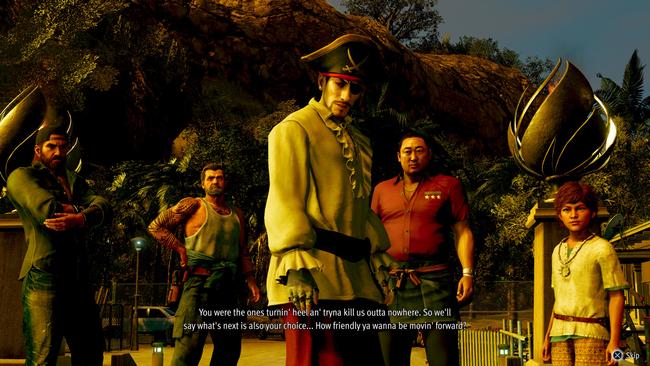
Instead, Pirate Yakuza in Hawaii’s main story focuses on two pillars: the power relationship between various factions that are seeking the elusive, legendary treasure of Esperanza, and how Noah’s family has been affected by this treasure hunt that has spanned many years. These pillars stand on uneven grounds, though. I came away with the notion that the latter had a lot of untapped potential as the finale rolled around. That extends to the main antagonists that try to have their moment at the final stretch, but the rest of the game didn’t give them a meaningful build-up. The overall messiness of the main narrative surfaces during Pirate Yakuza in Hawaii’s final chapter, since a lot of climactic moments feel lackluster because the involved parties feel overall unexplored.
I simply disagree with where Pirate Yakuza in Hawaii chose to focus its narrative priorities, and I know that may be an odd thing to critique. A large chunk of the player’s moment-to-moment objectives when following the main story feel either relatively mundane or needless padding. Oftentimes significant plot movements come to the brink of happening – only for the story to tell players that they need to backtrack once more to do something real fast before proceeding.
For instance, a dramatic showdown is about to occur with one of the more significant antagonists at the Pirates Coliseum in the new Madlantis locale. There are several important plot threads that have been leading up to this moment. Just as it’s about to happen… Majima and his crew need to travel back to Honolulu to retrieve a supposedly powerful cannon that’s capable of damaging that individual’s ship, even though my current cannons can already fire deadly laser beams. This sort of sudden detouring does happen in other entries throughout the franchise, yet few get as egregious as Pirate Yakuza in Hawaii.
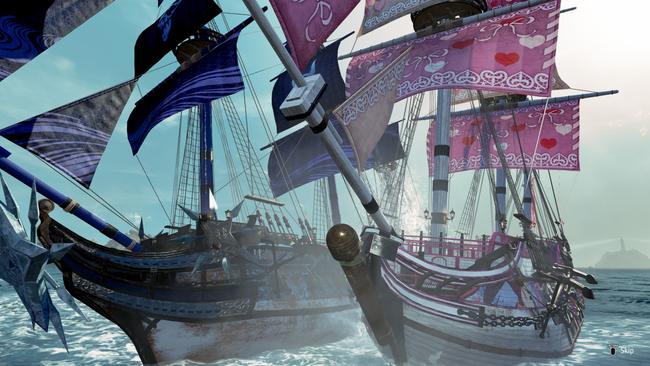
Despite my gripes with the main story, it’s still serviceable. There is still a healthy dose of hard-hitting yakuza drama amidst the absurdity of the premise. I do find it a bit strange how much Noah hangs around Majima on a moment-to-moment basis, especially when Majima is heading towards somewhere dangerous and Noah just tags along.
Leaving all that aside, another reason I recommend playing Infinite Wealth before Pirate Yakuza in Hawaii is because of the substories. There are quite a handful of substories in this game that follow-up on their plotlines in Infinite Wealth. Once again, it isn’t essential, yet revisiting these characters after what they went through previously makes their small inclusion that more impactful.
There is one new specific substory arc that caught me off-guard. It consists of a chain of substories that culminate in an ultimate finale that might be one of the most uncomfortable and awkward conclusions to a substory in the entire Yakuza / Like a Dragon franchise - and that’s quite a feat to accomplish. I wish I could delve more into this, but I do not want to spoil any part of it; I guess I’m curious to see how it’ll land with players once they get there and experience it for themselves. I understood the intent of what this substory was trying to convey, though I really don’t know if its presentation stuck the landing.
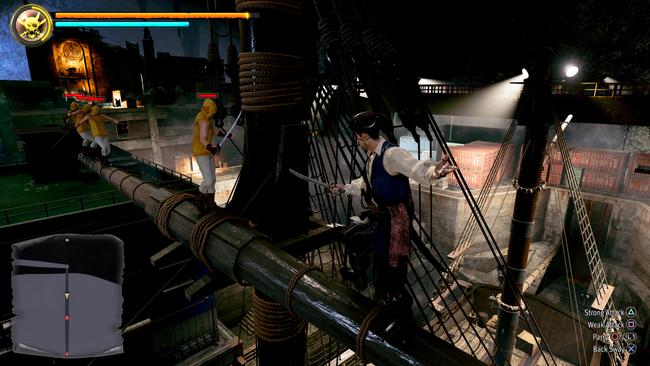
Like with The Man Who Erased His Name, Pirate Yakuza in Hawaii has RGG Studio dip their toes back into the real-time beat ‘em up genre once more. Majima, like Kiryu in his gaiden entry, possesses two battle styles: one that represents his legacy signature fighting style (Mad Dog) and the newly added one with many new toys (Sea Dog). The flow of combat is speedy and agile, much like the ebb and flow of Lost Judgment’s combat system. Players can freely quick-swap between battle styles in the middle of attack strings to juggle foes.
One of the biggest additions this installment brings to the table is the jump button in combat. Believe it or not, this is the first game in the entire series that allows players to manually jump during battles. Some heavy attack enders launch a foe straight into the air, and Majima can automatically follow them to continue his assault. Several skills can launch an enemy upwards even sooner; one is amusingly reminiscent of the iconic Electric Wind God Fist maneuver from Tekken.
Mad Dog in Pirate Yakuza in Hawaii is the most complete realization of Majima’s contemporary fighting style after his arc in Yakuza 0. Since Yakuza Kiwami 2’s Majima Saga was so brief, the Mad Dog of Shimano never quite had the chance to show the full extent of his combat abilities when players controlled him. The Mad Dog style has some of the fastest animations in the series’ history as it combines a variety of swift punches, kicks, and knife abilities to make Majima feel powerful right away.
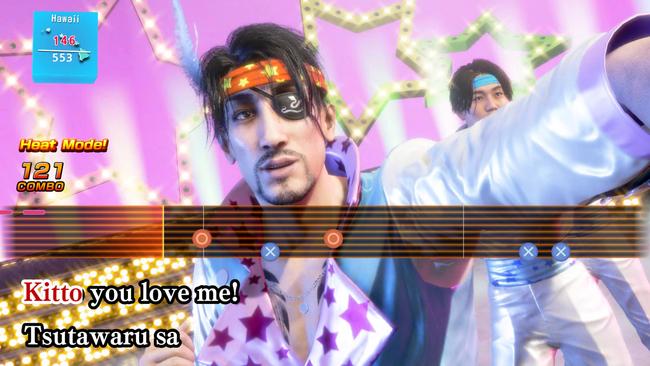
All the annoying moves that veterans remember from fighting Majima over the years are all intact and are at their disposal now. That incredibly fast stab thrust? It’s here. The spinning tornado slash? Yep. Majima can even call upon his doppelgangers through the new Madness Gauge, which ostensibly serves as an ultimate move that charges up through dealing damage and Heat Actions. When it’s utilized in Mad Dog, Majima will summon his doppelgangers for a limited time to help him out as they attack on their own, or enhance his other moves since they can act as afterimages that repeat his action; basically, V-ISM from Street Fighter Alpha 3.
On the other hand, the pirate-centric Sea Dog battle style brings a breath of fresh air that adds many new fun toys. Its dual cutlasses allow Majima to block attacks from any direction and they can be tossed out like boomerangs. Majima eventually expands the Sea Dog’s arsenal with a trusty pistol and chain hook, as well. These are incredibly fun tools that give the Yakuza beat ‘em up format a unique flavor. Some of the ability upgrades that the Sea Dog style can tap into makes this feel like one of the strongest styles the series has seen yet.
The Madness Gauge truly lives up to its name when executed in the Sea Dog style. Majima can obtain up to four cursed “dark instruments” throughout an extensive, optional side story. When the Madness Gauge is available, players can freely choose one of them to play, in order to summon an animal to devastate their foes. The starting violin dark instrument, for example, calls upon a horde of sharks to munch on Majima’s enemies. It is utterly ridiculous and I love it.
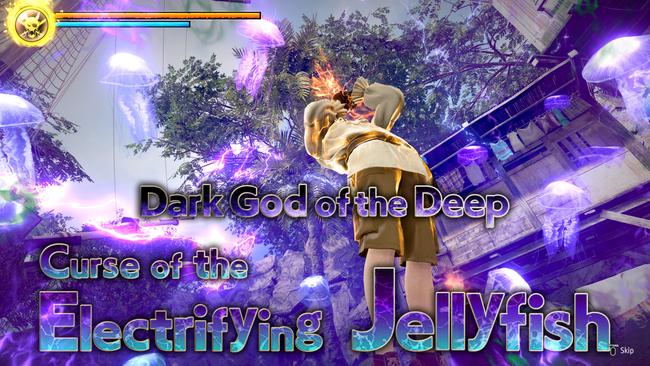
All of Majima’s combat options culminate into a game that… frankly, can’t keep up with the power level of Majima. His stat and ability upgrade options cost money and reputation points, and after a certain point early on, they become trivial to accrue. Despite the expansive combo juggle options at the player’s fingertips, I found it much more effective to zip through the battlefield via abilities that traverse in-and-out very fast, as they deal gigantic bursts of damage.
It provides a safer, stable route of damage, since Pirate Yakuza in Hawaii throws large numbers of enemies wielding firearms at Majima. There are so many of them at regular intervals that the game even included a visual and sound indicator that lights up and beeps when someone is about to fire at Majima, to let players know to dodge it immediately. Therefore, staying still against groups of enemies increasingly becomes a liability and finding ways to effectively deal damage while being as nimble as possible starts to show cracks for tactics that the game didn’t seem to account for.
Though the enemy AI feels more aggressive than the average Yakuza entry, it can’t keep up with simple strategies, such as hit-and-run tactics like performing a heavy attack off a chain hook approach continuously. I eventually began shredding through normal enemy encounters and bosses without taking damage because the game couldn’t keep up. Nevertheless, I still found Pirate Yakuza in Hawaii’s combat system very enjoyable, because it gives players a lot of options; it’s just that some of the options increasingly become more optimal as time went on.
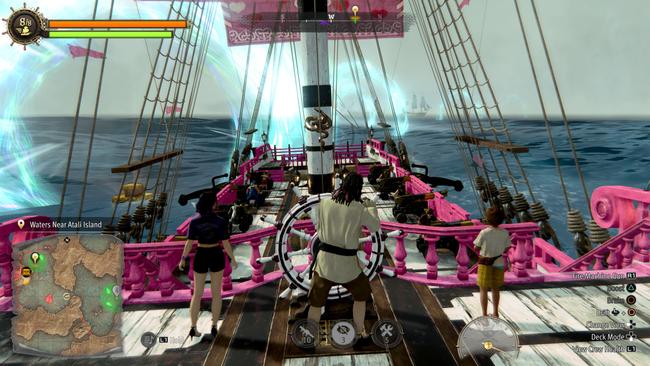
Of course, a big focus of any pirate game should be combat on the open seas. To clarify, Pirate Yakuza in Hawaii isn’t an open world game; each main landmark has a small sea map associated with them, so people are traversing through the seas surrounding Honolulu or Madlantis before reaching the landmass themselves. The landmarks and a few lighthouses spread across these sea maps serve as fast travel points, so players don’t have to always sail everywhere, if they’ve already opened those points up.
Ship-to-ship combat is largely fine; I don’t think it’s excellent, nor is it awful. There’s an arcadey feel to it, as it relies on flashiness to carry its simplicity, which isn’t a bad thing. The front of the ship is armed with machine guns that only fire straight ahead, while the left and right sides are lined up with cannons.
Each of these three weapons can be upgraded and/or swapped out with other armaments. If players want to swap out the typical cannonball with laser-firing turrets or flamethrowers, they’re free to do so - provided that they have the necessary materials to unlock them at Julie’s Gearworks shop. The side weaponry don’t have to both be the same type of weapons; the left side can have the lasers, while the right side can have the flamethrowers, and such. Unfortunately, the machine guns at the front must always be a machine gun, though there are a few different machine guns to choose from.
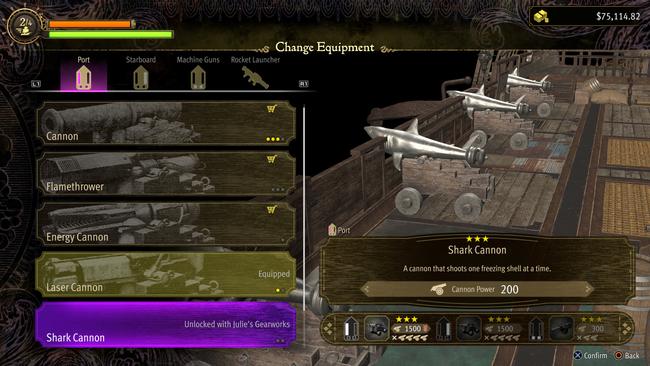
Facing off against other ships is more sluggish than what I wanted it to be. The ship’s base movement speed is incredibly slow without the booster thrusters accelerating it to a somewhat acceptable degree. While the booster gauge refills automatically per use, people can spend a fuel barrel consumable resource to immediately turn on the pirate ship’s thrusters again, even if the booster gauge hasn’t completely filled up. These fuel barrels can be obtained while sailing around, sinking an enemy ship, or entering the safe zones around fast travel points.
During boosts, players can drift Majima’s pirate ship to make sharp turns. Disposing enemy ships becomes a combination of ramming into them, aligning them with the sides of Majima’s ship to fire off its weapons, and pelting them away with machine guns in the interim. Aiming for 100% boost movement upkeep is ideal, since the base movement is so relatively slow. If Majima's ship is damaged too much, a crewmember may faint which will disable the weapon they were manning. Players will have to switch to the "pirate deck" mode to quickly get them back up on their feet in the middle of combat; a smokescreen option provides a substantial defense boost temporarily to give people some peace of mind that their stalled ship won't immediately get shredded to bits.
It was disheartening to see that there was no ship upgrade option to speed up the pirate ship at all. Instead, the amount of held fuel barrels can be increased, yet it still felt like it wasn’t enough even when maxed out. Once again, I don’t dislike how Pirate Yakuza in Hawaii handled its naval combat, but I wouldn’t call it great either. There are wind current rings that people can follow to speed up navigation, though these are only available outside of naval combat encounters.
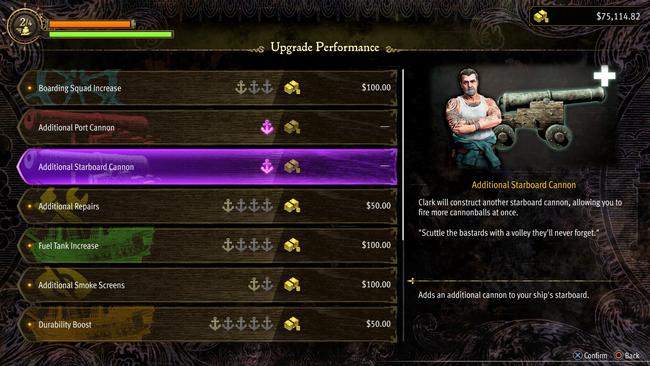
Several pirate ship showdowns include a boss ship that has an additional layer of combat. Once a boss ship’s HP is depleted, people must raid the boss ship with up to 20 NPC crewmates and wipe out all the enemies together. Completing this immediately ends the fight, no matter how many other remaining enemy ships there are. Although the lesser ships can be ignored, letting them remain during the raid can disrupt the invasion as their cannon fire will stagger Majima’s group occasionally.
Recruiting optional characters for Majima’s newfound pirate crew is one of Pirate Yakuza in Hawaii’s strongest aspects. Some can be found standing around throughout Honolulu and Madlantis, and tend to have a small requirement to have them join Majima. There are also crewmates available in most of the minigame shops, so there’s an even stronger incentive to try out a lot of the minigames in this new Like a Dragon entry. Substories will often reward new crewmates, too.
Crewmates can be slotted into various roles on the pirate ship, from manning weaponry or participating in the ship invasions. They have different stats that correspond to how well they perform in each of those roles; some are more suited for naval combat, while others shine in more direct confrontations.
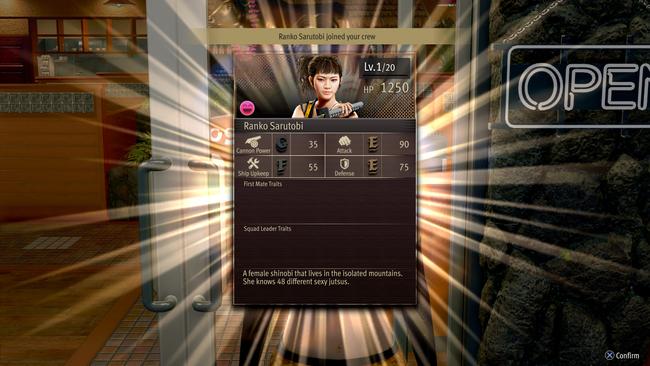
Even though there is technically a “rarity” assigned to crewmates that determine their max level, there is still value in lower rarity crewmates because of exclusive abilities. For instance, the Crazy Delivery minigame NPC may be bronze-ranked, but they have an exclusive AoE ability that involves the bike. Meanwhile, the Alo-Happy mascot whips out a flamethrower that can do friendly fire damage.
Players can even take up to four crewmates with them in the optional island exploration sections scattered throughout the sea maps that contain lost treasures and relics, which provide a good chunk of money and reputation. They usually consist of small narrow maps that have a boss encounter at the end, or a horde of enemies that continually spawn in waves at a set location. These are small activities that help incentivize exploring the various zones around each sea map.
RPG collectionists might be in danger, since there is a comprehensive treasure list index, and obtaining them all requires engaging with almost every single minigame. To tempt players down this dangerous path, RGG Studio has placed gigantic treasure chests right beside almost every NPC that offers a unique piece of treasure in their corresponding shop. I… engaged with shogi earnestly for the first time in this entire series because of this ploy. Therefore, I learned how each piece could move, and proceeded to go to a website that told me the best moves to make every single turn to beat the shogi CPUs, so I could earn enough points to purchase not only the shogi minigame shop’s treasure, but its exclusive crewmates, as well.
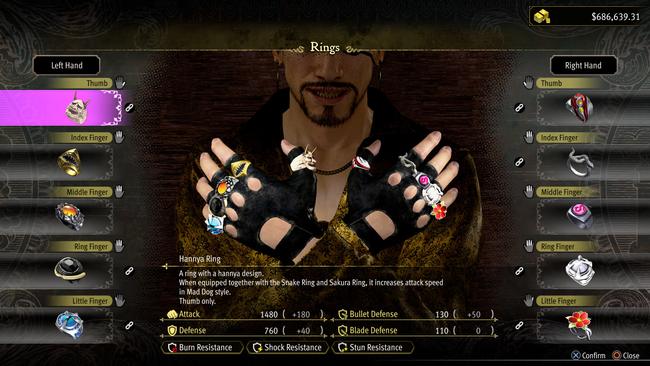
There are numerous other gameplay systems I enjoyed in Pirate Yakuza in Hawaii, though I’ve gone into the weeds long enough. A few I’ll mention are the ten rings that Majima can wear on each of his fingers to provide him additional stats; this is a neat system because there are actually some set bonuses, if a combination of rings are worn which is reminiscent of how isometric loot-driven action RPGs handle their progression systems. The costume customization from The Man Who Erased His Name is expanded upon in Pirate Yakuza in Hawaii, because Majima can not only change how his outfits in both styles, but also his pirate ship, too.
I did experience a few crashes in my PC review copy of this game, though I’m not sure how prevalent of an issue this will be. After speaking with a few of my peers that have also been playing Pirate Yakuza in Hawaii, they seem to not have experienced any crashes at all. My crashes always seemed to occur only during story cutscenes, after the game had been on for roughly 3-4 hours. This occurred more in the final third of the game, so it quickly became annoying when I had to replay sections because it didn’t autosave often as much, and I didn’t have the option to save manually in those parts. I experienced a total of roughly six crashes in my thorough 40-hour playthrough.
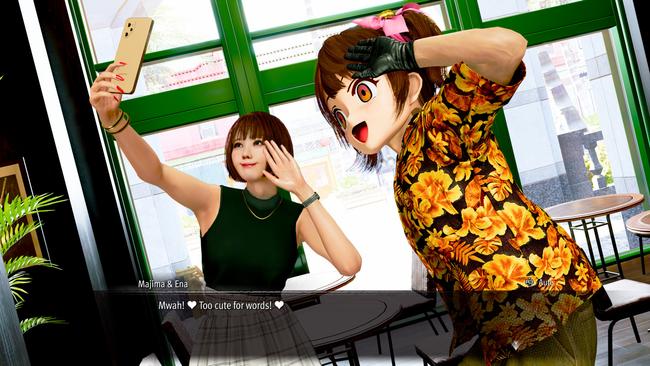
Like a Dragon: Pirate Yakuza is difficult for me to evaluate. The aspects of the main narrative it chooses to dwell on seems unevenly paced, and strangely misguided at times. Its combat system is slick, especially with all the tools that the brand-new Sea Dog style brings to the table - yet the balance of power feels lopsided in Majima’s favor to the point that enemy AI can’t keep up. A lot of its pirate-oriented systems feel like a jack-of-all-trades; they’re all competent and serviceable, though only provide a surface-level layer of satisfaction. I like a lot of what Pirate Yakuza in Hawaii is putting down, but I can’t ignore the numerous significant misfires either.